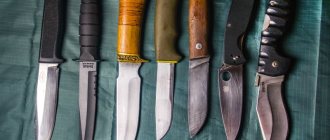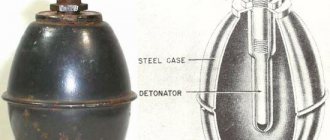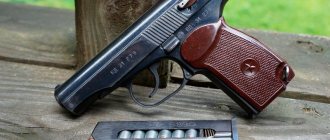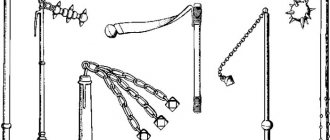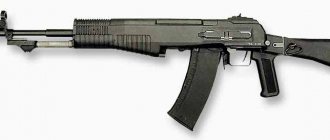| TV Tropes For English speakers and those who want to get to know the topic even more deeply, the TV Tropes project has an article by Epic Flail. You can also help our project and transfer valuable information from there to this article. |
From two hands and from a horse! (Korean cavalry)
What to do if the enemy is clad in armor? Pound him with a heavy impact weapon or try to pierce the armor in a vulnerable place. What if he also covers himself with a shield? Oh, let's look at the peasant's threshing hammer - try to hide from this! This is roughly what the people who attached a small weighty weight to the chain reasoned...
This is how the battle flail appeared. The democratic choice is equally suitable for a knight who needs a weapon to beat enemies from a horse after losing his spear, and for a dashing man on the high road, and for a militiaman who needs to hurry up the proverbial knight. This weapon appeared in time immemorial and disappeared from the scene by the 19th century... although wait, it never went anywhere, the trench battles of the First World War and modern mass unrest will not let you lie.
What are the advantages and disadvantages of a flail?
- Pros: Monstrous impact force - comparable to the blow of a war hammer with a fairly small weight of the weapon.
- Compactness is, of course, not the case with a two-handed thresher.
- It is difficult to predict where the blow will be directed.
- You can’t hide from it: it goes around not just a block with a weapon, even a shield (and hits the hand, making it impossible to use it normally).
- Psychological effect: a ball covered with spikes, whistling through the air - this is scary. And if you take two, it’s even worse (but more useless). Although if in different hands, then, as Dahl said, “there was no hand-to-hand attack against such a fighter.”
- Cheap and easy to manufacture - a primitive flail can be assembled from scrap materials. The quality will be low, but suitable for self-defense.
- One hit weapon. You can still parry a blow with a mace or war hammer, although it is more difficult than with a sword. This is no way. Therefore, either a shield or - count on the blow to be successful. You can block a blow with the shaft. If it is strong enough not to be cut. You cannot block a well-placed blow with a shaft (checked). But it is quite possible to parry.
- Once you start hitting with a mace, you can stop, although this is not so easy. The flail will hit something. It is possible to stop a blow with a flail, but this requires very good weapon skill, and there is unlikely to be time for this in a big fight.
There are several types of combat flail: 1) Extinguisher - a primitive version, just a weight on a rope, strap or chain wrapped around the hand. It was loved by all sorts of robbers and ordinary people because of its compactness. 2) Flail - the same extinguisher, but on a short handle. Not a bad choice for a rider. From a relatively small fighting whip with a spiked weight to a 1.5-kilogram Kettenmorgenstern with long spikes. 3) Threshed - hell and destruction. Derived from a peasant's flail. A shaft the length of a man, at the end on a short chain or a weight, or a log bound with iron and studded with nails. Much lighter than a halberd, but its impact is much slower. This is a one-ass punch weapon, guaranteed to break through and crush everything in its path.
A subspecies of the flail can be considered nunchucks (in “maidenhood”, again, a peasant flail) and a meteor hammer - extinguished on a very long (from 3 to 5 meters) cable, which was additionally accelerated by unwinding or by overwhelming any part of the owner’s body, then with a sharp with a jerk they sent the cargo flying towards the enemy at a decent speed.
Like war hammers and maces, in popular culture flails suffer from gigantomania, sometimes comparing the warhead to the size of a 32-kilogram weight. Also common are attempts to attach from two to a dozen chains with weights to one handle - such a weapon actually existed, it was called a “kropach”, but due to the inconvenience it was rarely seen.
A similar trope in the animal world is the tail-snatch.
Giant star
The largest known kettenmorgenstern is kept in the Armory Museum of Graz, Austria. The total length, including the handle along with the 17-link chain and the oval 14-spike striker, is 252 cm. Data on the weight of the entire weapon has not been published, but the weight of the striker is known and is 12 kg!
Design
A traditional product of the peoples of East Asia consists of several parts:
- Hima. It is a rope, hose or chain that connects two rods.
- Circuit. This is the name given to the upper part of the handle, decorated with special metal inserts.
- Joy-con. The upper part of the handle, following the metal inserts.
- Kugun-bu. This is the central part.
- I-Con. The lower part, consisting of heads, additionally processed at the factory.
About weaknesses
Despite the presence of undeniable advantages, the “rising star” had the following disadvantages:
- Because of the sharp spikes, it was impossible to sew a cover for the morning star. Therefore, during transportation, the soldiers had a lot of trouble: the weapon clung to their clothes, and it was not easy to walk with it. In addition, a warrior wielding a morning star posed a danger to “his own people.”
- The Rising Star is considered a rather primitive weapon. They were only hit vertically. If the enemy was not ready for this and did not have time to cover himself with a shield in time, then he was guaranteed a traumatic brain injury.
- Since the working part of this medieval weapon was a spiked pommel, the warrior had to calculate the distance in such a way that it hit the target. If the enemy shortened the distance, the warrior found himself in a blind spot, in which the morning star was absolutely useless.
Usage
Rods with a chain are still used to teach the basics of martial arts. To use the model, you must have special equipment. This is due to two features:
- during continuous movement it is almost impossible to intercept a weapon;
- when the rod can be intercepted, the angle of movement changes, which increases the force of the blow.
When fighting, various techniques are used to disarm a person. In the nunchuck technique, it is common to make strangling and holding clamps, and use low martial arts techniques.
Russian flail
In our country, the weapon of the Czech rebels is considered a classic battle flail. But in the regions where the descendants of the Hussites and Landsknechts live, it is customary to think that the birthplace of these weapons is... Kievan Rus! Not only in weapons treatises of the Czechoslovak period, but also in modern publications, there are regularly references to military flails with a huge club-shaped blow, supposedly dating from pre-Mongol times and stored in museums in Kyiv. But any similar weapons are exhibited mainly in the collections of the Moscow State Historical Museum, and all samples date back to the 17th–18th centuries! It seems that modern weapons experts in the Czech Republic and Germany confuse Kievan Rus with Muscovite.
Where did such bladed weapons come from?
Judging by its shape, the flail is clearly intended for horse fighting. This is due to the lightness of the weapon and its great mobility. A horseman who skillfully handled such weapons and mastered the techniques of equestrian combat could freely deliver a sudden, devastating blow to the enemy. The force of the backhand strike was so strong that the opponent could easily be knocked out of the saddle. If the blow fell casually, then the rider who remained in the saddle would be stunned for some time. Only a shield could save him from a crushing blow from a metal weight. The steel armor of warriors rarely provided reliable protection from a deafening blow from a heavy weight during a combat clash. The large kinetic energy during the swing, multiplied by the weight of the weapon, provided enormous force to the blow. The only argument that could be opposed to such cold weapons was striking first.
It should be noted that during the battle, the flail was rarely used. Rather, it was an auxiliary weapon that warriors used when it was impossible to use the main types of weapons. If a spear or pike was lost, or a sword was lost, such a bladed weapon as a flail became the last powerful argument for a warrior. However, many warriors from among the nobility neglected the combat capabilities of such weapons, considering them to be the weapons of commoners.
The first information about the combat use of the flail appeared in Europe at the beginning of the 11th century. Over time, it became clear that such a device, used as a bladed weapon, is quite common in the world. Weights on a chain were used by knights of medieval England, Germany and Italy during the Crusades. Muslims also had similar weapons. The heavily armed horsemen of Salah ad-Din's army used flails in confrontation with the knights - the crusaders. In ancient Japanese drawings and frescoes you can see a flail on the equipment of samurai.
Russian warriors
In the form in which we present this weapon, it appeared much later. Originally it was a battle flail, very reminiscent of a device for threshing grain. Later, attempts were made to modernize this type of bladed weapon, making it more respectable and representative. In Rus', a similar type of weapon was used during the campaigns of the ancient Russian princes against Constantinople and in battles with the Polovtsians and Pechenegs. Old Russian warriors were equipped with proven types of these weapons and mastered special combat techniques.
Kisten is a name with Slavic roots. The meaning of this word can be interpreted differently, but the essence does not change. The weapon was put on the hand and was activated by rotating the hand. Considering the fact that the Slavs had to fight for a long time against nomadic tribes of Turkic origin, an analogy can be drawn with the Turkic name. “Kistan” translated from the Turkic language means “stick”.
Impact part
The popularity of the weapon is explained by its simple design and low cost. The prototype of the combat flail is a threshing stick, which was often used to arm the militia. Having quickly identified the fairly high effectiveness of the device in battle, they changed its shape. The stick was shortened, and a beater made from animal bones was attached to a chain. For wealthy warriors, the flail receives a metal beater. From a two-handed type, the weapon turns into a one-handed one, lighter and more flexible. Its impact-crushing effect is enhanced. In Rus', the name of the weapon was finally established, while in Europe such edged weapons are called in the German manner - morningstern.
Two-handed flail
Throughout the Middle Ages, two-handed agricultural flails were sometimes used as weapons by peasant armies conscripted into military service or participating in popular uprisings. For example, in the period 1420-1497, the Hussite armies consisted of a large number of peasant infantrymen armed with flails.
The shock load of the weapon was often equipped with pins and spikes to enhance its damaging characteristics against infantry, the manufacture of which required high lathe skills, after which the flail ceased to look like a simple agricultural tool in the hands of a rural rebel. A modified flail was used in the Peasants' War in 16th century Germany.
Later, the long-handled flail was in service in India. The exhibit can be seen at the Pitt Rivers Museum; the weapon has a wooden impact weight studded with iron spikes. The Royal Armories house a weapon that combines two spiked impact weights at once, attached to a single handle.
The main advantage that a two-handed flail gives its owner is the ability to successfully resist an enemy equipped with a shield. The main disadvantage is the low accuracy of strikes and the difficulty of conducting close combat.
Gallery[edit]
- Hayo van Wolwega attacks the tower of Damietta with a flail during the 5th Crusade
- Two-handed flail with metal spikes
- Detail from The Travels of Marco Polo, circa 1410, showing a "Mamluk" in armor with a short pointed flail tucked into his belt.
- Detail from The Travels of Marco Polo, circa 1410, showing a horseman using both hands to hit an opponent with a spiked flail.
- Illustration from Bellifortis showing a horseman with a short flail, circa 1450.
- Hussite troops with flails on the march
Links[edit]
- ^ ab Eduard Wagner; Zoroslava Drobna; Jan Durdik (5 May 2014). Medieval costume, armor and weapons. Courier Corporation. ISBN 978-0-486-32025-0.
- Stephen Turnbull: The Hussite Wars 1419-36, Osprey MAA 409,2004
- media: 344Wagenburg der Hussiten.jpg Media: Hussites massacre.jpg
- Maximilian I. "Color plate showing knights fighting with two-handed flails". Freydal
. Retrieved January 19, 2016. - ↑
Douglas Miller: The Armies of the German Peasants' War 1524-26, Osprey MAA 384,2003 - Media: German Peasants War.jpg
- Talhoffer (p. 1450). "Talhoffer Fechtbuch (MS 78.A.15) Folio 60r". wiktenauer.com
. Retrieved February 1, 2016. - Talhoffer (p. 1450). "Talhoffer Fechtbuch (MS 78.A.15) Folio 60v". wiktenauer.com
. Retrieved February 1, 2016. - Michael Hundt (1611). "Ein new Kůnstliches Fechtbuch im Rappier - Figure 88". wiktenauer.com
. Retrieved February 1, 2016. - Jacoba Sutor von Baden (1612). "New Kůnstliches Fechtbuch - Page 108". wiktenauer.com
. Retrieved February 1, 2016. - DeVries, Kelly (2012). Medieval military equipment
. North York, Ontario. Tonawanda, NY: University of Toronto Press. paragraph 30. ISBN 1-4426-0497-2. - ↑
Dr. Paul B. Sturtevant (May 12, 2016).
"The mysterious story of a non-existent weapon". Public medieval figure
. Retrieved June 1, 2016. - ^ab DeVries, Kelly (2007). Medieval Weapons and an Illustrated History of Their Impact. Santa Barbara, CA: ABC-CLIO. paragraph 133. ISBN 1-85109-526-8.
- Nicholas Lloyd (1 December 2014). "'Morning Star' flail". YouTube
. Retrieved February 24, 2015. - "War Flail". Metropolitan Museum of Art. Retrieved February 24, 2015.
- "War Flail". Metropolitan Museum of Art. Retrieved February 24, 2015.
- "War Flail". Metropolitan Museum of Art. Retrieved February 24, 2015.
- Kotovich, Petr Nikolaevich (2008). "Early medieval battle flails (kisen) from the Polish lands" (PDF). Fasciculi Archaeologiae Historicae
.
XXI
: 75–86. - ^ab Waldman, John (2005). Created weapons in medieval and Renaissance Europe, the evolution of European staff weapons between 1200 and 1650. Boston: Brill. pp. 145 -150. ISBN 90-04-14409-9.
- “네이버 지식 iN :: 지식 과 내가 함께 커가 는 곳” . Kin.naver.com. Retrieved December 18, 2012.
- "네이버 지식 백과" . 100.naver.com. Retrieved December 18, 2012.
- "VOTE!" . Dvdprime.donga.com. 2009-05-08. Archived from the original on 2014-01-18. Retrieved December 18, 2012.
Nunchakus these days
Nunchakus are used in one of the directions called Okinawan Kobudo. All sports fights are carried out exclusively with soft nunchucks and protective helmets. To defeat your opponent, you need to score 6 points. Points are awarded for each hit.
At official competitions, specially approved implements are used. In addition, when creating an access list, the age and height of partners are taken into account. For example, in the height category up to 150 centimeters, rods up to 25 centimeters long are used.
Swinging the chain across the blinkers
The teeth add weight to the argument.
How were they used? No one, of course, spent many years mastering this instrument. The basic method of using a long chain is well described by Anthony Burgess in "area to area". It was important here that the instrument did not get stuck in the enemy’s ranks or get wrapped around someone. After all, the law of a mass fight is simple - swing and hit as often as possible. Accuracy and effectiveness of hitting is the tenth thing. In addition, some individuals carried such chains as quite compact devices with them. After all, a flexible weapon has one important advantage - by setting it in motion, you can use its inertia to brush off several enemies. And despite the fact that it is very difficult to kill with a chain, it hits painfully. In general, an almost ideal weapon for a street fighter.
